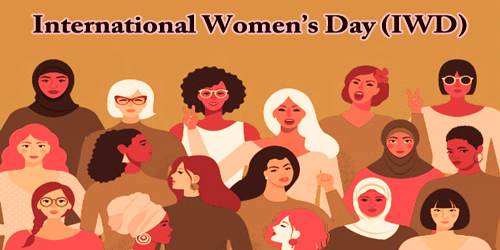International Women’s Day (March 8) is a global day celebrating the social, economic, cultural and political achievements of women. It is a focal point in the movement for women’s rights. A national holiday in numerous countries, it has been sponsored by the United Nations (UN) since 1975.
After the Socialist Party of America organized a Women’s Day in New York City on February 28, 1909, German delegates Clara Zetkin, Käte Duncker and others proposed at the 1910 International Socialist Woman’s Conference that “a special Women’s Day” be organized annually. After women gained suffrage in Soviet Russia in 1917, March 8 became a national holiday there. The day was then predominantly celebrated by the socialist movement and communist countries until it was adopted by the feminist movement in about 1967. In some places, it is a day of protest; in others, it is a day that celebrates womanhood.
No one government, NGO, charity, corporation, academic institution, women’s network or media hub is solely responsible for International Women’s Day (IWD). Many organizations declare an annual IWD theme that supports their specific agenda or cause, and some of these are adopted more widely with relevance than others. International Women’s Day is a collective day of global celebration and a call for gender parity.
History –
International Women’s Day (IWD) grew out of efforts in the early 20th century to promote women’s rights, especially suffrage. In its campaign for female enfranchisement, the Socialist Party of America in 1909 held the first National Woman’s Day, which was highlighted by mass meetings across the United States; the day was observed until 1913. Encouraged by German activist Clara Zetkin, the International Socialist Congress agreed in 1910 to create an international version of the U.S. holiday, and on March 19, 1911, the first IWD was held in Austria, Denmark, Germany, and Switzerland. More than one million people attended rallies marking the day. In the ensuing years the IWD was celebrated in additional countries and on varying dates.
In 1913 Russian women observed their first International Women’s Day on the last Saturday in February (by the Julian calendar then used in Russia). In 1914, International Women’s Day was held on March 8 in Germany, possibly because that day was a Sunday, and now it is always held on March 8 in all countries. The 1914 observance of the Day in Germany was dedicated to women’s right to vote, which German women did not win until 1918.
In London there was a march from Bow to Trafalgar Square in support of women’s suffrage on March 8, 1914. Activist Sylvia Pankhurst was arrested in front of Charing Cross station on her way to speak in Trafalgar Square.
On March 8 (February 24, Old Style), 1917, women in Petrograd (St. Petersburg), Russia, marked the day by staging a strike to protest food shortages, poor living conditions, and World War I. This strike for “bread and peace” helped give rise to the Russian Revolution of 1917, which led to the abdication of Nicholas II on March 15 (March 2). In 1921 the date of the IWD was officially changed to March 8.
International Women’s Day was celebrated for the first time by the United Nations in 1975. Then in December 1977, the General Assembly adopted a resolution proclaiming a United Nations Day for Women’s Rights and International Peace to be observed on any day of the year by Member States, in accordance with their historical and national traditions.
The UN commenced the adoption of an annual theme in 1996 which was “Celebrating the past, Planning for the Future”. This theme was followed in 1997 with “Women at the Peace table”, and in 1998 with “Women and Human Rights”, and in 1999 with “World Free of Violence Against Women”, and so on each year until the current. More recent themes have included, for example, “Empower Rural Women, End Poverty & Hunger” and “A Promise is a Promise Time for Action to End Violence Against Women”.
International Women’s Day sparked violence in Tehran, Iran on March 4, 2007, when police beat hundreds of men and women who were planning a rally. (A previous rally for the occasion was held in Tehran in 2003.) Police arrested dozens of women and some were released after several days of solitary confinement and interrogation. Shadi Sadr, Mahbubeh Abbasgholizadeh and several more community activists were released on March 19, 2007, ending a fifteen-day hunger strike.
In the twenty–first century, in the West, the day was increasingly sponsored by major corporations and used to promote feel–good messages, rather than radical social reforms. In 2009, the British marketing firm, Aurora Ventures, set up a “International Women’s Day” website with corporate sponsorship. The website began to promote hashtags (#) as themes for the day, which became used internationally. The day was commemorated by business breakfasts and social media communications that were reminiscent of Mother’s Day greetings.
Celebrating the Day –
On this day it is customary for men to give the women in their lives friends, mothers, wives, girlfriends, daughters, colleagues, etc. flowers and small gifts (although to many this seems cloyingly old-fashioned and rather to miss the point). In some countries (such as Bulgaria and Romania) it is also observed as an equivalent of Mother’s Day, where children also give small presents to their mothers and grandmothers.
The emerging global consensus is that despite some progress, real change has been agonizingly slow for the majority of women and girls in the world. Today, not a single country can claim to have achieved gender equality. Multiple obstacles remain unchanged in law and in culture. Women and girls continue to be undervalued; they work more and earn less and have fewer choices; and experience multiple forms of violence at home and in public spaces. Furthermore, there is a significant threat of rollback of hard-won feminist gains.
A global web of rich and diverse local activity connects women from all around the world ranging from political rallies, business conferences, and government activities and networking events through to local women’s craft markets, theatric performances, fashion parades and more. Many global corporations actively support International Women’s Day (IWD) by running their own events and campaigns. For example, on 8 March search engine and media giant Google often changes its Google Doodle on its global search pages to honor IWD. Year on year IWD is certainly increasing in status.
Information Sources:
















